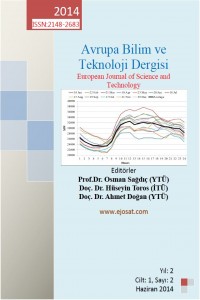Abstract
References
- Albadi M. H., El-Saadany E.F., 2007. Demand Response in Electricity Markets: An Overview, Power Engineering Society General Meeting, 24-28 June 2007, IEEE.
- ASME, 2009. Reducing Carbon Dioxide Emissions, Technology and Policy Recommendations and Goals for in the Energy Sector, 1828 L Street NW, Suite 906, Washington, DC 20036-5104 U.S.A., pp 35.
- Auffhammer M., Blumstein C., Fowlie M., 2008. Demand-side Management and Energy Efficiency Revisited. The Energy Journal. ar): 29;3: 91-104.
- Balat, M., 2008. Energy consumption and economic growth in Turkey during the past two decades. Energy Policy 36, 118– 127.
- Bilen K., Ozyurt O., Bakırcı K., Karslı S., Erdogan S., Yılmaz M., Comaklı O., 2008. Energy production, consumption, and environmental pollution for sustainable development: A case study in Turkey, Renewable and Sustainable Energy Reviews, 12:1529–1561.
- EPA, 2012. eGRID2012 Version 1.0, U.S. annual non-baseload CO2 output emission rate, year 2009 data, U.S. Environmental Protection Agency, Washington, DC.
- Ercelebi S.G. Toros H. 2009. Extreme Value Analysis of Istanbul Air Pollution Data. CLEAN Soil Air Water 37, 122-131. EUAS, 2010.
- EÜAŞ, Electricity Generation Company, 2010, Annual Report
- Hacisalihoglu B., 2008. Turkey’s natural gas policy. Energy Policy 36 (2008) 1867–1872
- http://www.computer.org/portal/web/csdl/doi/10.1109 /FSKD.2009.487
- http://www.electripedia.info/consumers.asp http://www.jstor.org/stable/1056848?seq=9
- Kilic F.C., Kaya D., 2007. Energy production, consumption, policies, and recent developments in Turkey. Renewable and Sustainable Energy Reviews, 11:1312–1320.
- Komine T., Nakagawa M., 2003. Integrated System of White LED Visible-Light Communication and Power-Line Communication, IEEE Transactions on Consumer Electronics, 49;1:71 – 79.
- Lin Y.J., Latchman H.A., Lee M., Katar S., 2002. A power line communication network infrastructure for the smart home. IEEE Wireless Communications 9;6:104-111.
- Pavlidou N., Han Vinck A.J., Yazdani J., Honary B., 2003. Power line communications: state of the art and future trends. IEEE Communications Magazine 41;4:34 – 40
- Toros H., Erdun H., Çapraz Ö., Özer B., Daylan E.B., Öztürk A.İ., 2013. Air Pollution and Quality Level in Metropolitan Turkey for Sustainable life, European Journal of Science and Technology, EJOSAT, 1, 12-18.
- Yousuf M.S., Rizvi S.Z., El-Shafei M., 2008. Power Line Communications: An Overview Part II. This paper appears in: Information and Communication Technologies: From Theory to Applications, 3rd International Conference on Issue Date: 7-11 April 2008, ICTTA, 1-6.
Abstract
Artan enerji talebi ve çevreye zararı yeni çözümler aranmasını ihtiyaç haline getirmektedir. Tüketim ve tüketimdeki düzensizlikler fazla elektrik üretimine yol açmaktadır. Elektrik enerjisi kullanım alanındaki artış dolayısıyla yeni enerji kaynaklarına ihtiyaç vardır. Zaman içerisinde elektrik tüketim ve üretimindeki salınımlar iyi bir planlamayı gerektirmektedir. Bu yüzden, enerji kaynaklarının verimli ve planlı kullanılması gerekmektedir. Elektrik üretiminin daha çok termik santrallerde yapılma çevre problemini de beraberinde getirmektedir. Termal elektrik üretim santrallerinde tüketime bağlı olarak üretimi ayarlamanın zorluğu sebebiyle tüketimde ani tüketimlerin ayarlanması fazla üretimin azalmasına ve dolaylı olarak çevreye verilen zararın azalmasına katkı sağlayacaktır. Üretim ve tüketim arasındaki dengesizliği azaltmak amacıyla ulusal ve bölgesel olarak çözümler yapılabilir. Bu çalışmada üretim ve tüketim arasındaki dengesizliği azaltmak amacıyla hali hazırda kullanılan sistemden farklı bir yöntem önerilmektedir. Önerilen sistemde elektrik tüketimine bağlı olarak elektrik tüketim ücretlendirilmesi online olarak 8 farklı kategoride tüketiciye elektrik hatları üzerinden sunulacaktır. Elektrik kullanım yerlerinde göstergeler ve akıllı cihazlar kanalıyla tüketiciler elektriğin fiyatının ucuz olduğu saatlerde acil olmayan ihtiyaçlarını gidermeye teşvik edilecektir.
References
- Albadi M. H., El-Saadany E.F., 2007. Demand Response in Electricity Markets: An Overview, Power Engineering Society General Meeting, 24-28 June 2007, IEEE.
- ASME, 2009. Reducing Carbon Dioxide Emissions, Technology and Policy Recommendations and Goals for in the Energy Sector, 1828 L Street NW, Suite 906, Washington, DC 20036-5104 U.S.A., pp 35.
- Auffhammer M., Blumstein C., Fowlie M., 2008. Demand-side Management and Energy Efficiency Revisited. The Energy Journal. ar): 29;3: 91-104.
- Balat, M., 2008. Energy consumption and economic growth in Turkey during the past two decades. Energy Policy 36, 118– 127.
- Bilen K., Ozyurt O., Bakırcı K., Karslı S., Erdogan S., Yılmaz M., Comaklı O., 2008. Energy production, consumption, and environmental pollution for sustainable development: A case study in Turkey, Renewable and Sustainable Energy Reviews, 12:1529–1561.
- EPA, 2012. eGRID2012 Version 1.0, U.S. annual non-baseload CO2 output emission rate, year 2009 data, U.S. Environmental Protection Agency, Washington, DC.
- Ercelebi S.G. Toros H. 2009. Extreme Value Analysis of Istanbul Air Pollution Data. CLEAN Soil Air Water 37, 122-131. EUAS, 2010.
- EÜAŞ, Electricity Generation Company, 2010, Annual Report
- Hacisalihoglu B., 2008. Turkey’s natural gas policy. Energy Policy 36 (2008) 1867–1872
- http://www.computer.org/portal/web/csdl/doi/10.1109 /FSKD.2009.487
- http://www.electripedia.info/consumers.asp http://www.jstor.org/stable/1056848?seq=9
- Kilic F.C., Kaya D., 2007. Energy production, consumption, policies, and recent developments in Turkey. Renewable and Sustainable Energy Reviews, 11:1312–1320.
- Komine T., Nakagawa M., 2003. Integrated System of White LED Visible-Light Communication and Power-Line Communication, IEEE Transactions on Consumer Electronics, 49;1:71 – 79.
- Lin Y.J., Latchman H.A., Lee M., Katar S., 2002. A power line communication network infrastructure for the smart home. IEEE Wireless Communications 9;6:104-111.
- Pavlidou N., Han Vinck A.J., Yazdani J., Honary B., 2003. Power line communications: state of the art and future trends. IEEE Communications Magazine 41;4:34 – 40
- Toros H., Erdun H., Çapraz Ö., Özer B., Daylan E.B., Öztürk A.İ., 2013. Air Pollution and Quality Level in Metropolitan Turkey for Sustainable life, European Journal of Science and Technology, EJOSAT, 1, 12-18.
- Yousuf M.S., Rizvi S.Z., El-Shafei M., 2008. Power Line Communications: An Overview Part II. This paper appears in: Information and Communication Technologies: From Theory to Applications, 3rd International Conference on Issue Date: 7-11 April 2008, ICTTA, 1-6.
Details
| Primary Language | English |
|---|---|
| Subjects | Engineering |
| Journal Section | Articles |
| Authors | |
| Publication Date | July 5, 2014 |
| Published in Issue | Year 2014 Volume: 1 Issue: 2 |


